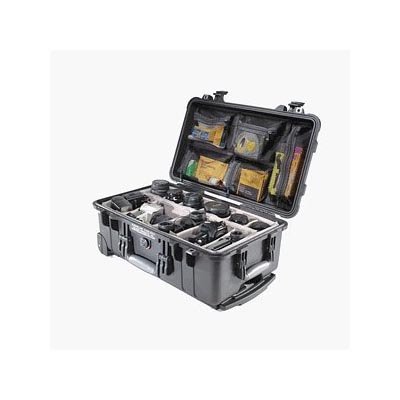Packing for a photographic trip will vary on many factors including the gear needed, mode of transport to your destination and what you are ultimately comfortable lugging around. While it is important to be prepared, it is equally as important to have just enough gear and no more. Bringing along obscure lenses or accessories that you won't need will cause you to miss shots and unnecessary fatigue. It's a delicate balance and important to give it some thought.
A common practice is to have a single bag/case for the equipment while en-route and bring along an additional "shooting" bag to use while you're actually shooting. The main bag you travel with will be one that you can hold nearly everything you bring. Load your main bag up to whatever extent is necessary to safely and securely transport your gear from point A to point B. This bag will never leave your sight while traveling. It should be small enough for aircraft carry-on limitations and built with enough protection to toss around in the overhead storage to keep your gear safe and sound. It will almost certainly be heavier than the airline guidelines of a carry-on - so just don't act like its heavy and you should be fine. Another "air travel" specific tip is to try and board early so that there is overhead space when you actually board. I'm an aisle type of guy so that means I am often in the last seating group which sometimes works against me.
Some of the most practical bags for your main travel bag are camera backpacks. They are easy to carry around for short distances, even when fully loaded. The 2 brands I especially like are ThinkTANK photo and Kata Bags. Some of these backpacks even convert to a rolling case. For even more protection and larger capacities I use a Pelican rolling case. I really like the Pelican case because if I am forced to check it as a last resort, I feel better knowing it can take more abuse.
There is one piece of gear that may not fit into your "carry on" camera bag/case - that is your tripod. Depending on what you are shooting, this may be be the most important accessory a photographer brings along. Many camera backpacks are designed to have the tripod attach to the outside of the bag but this may cause a problem fitting in an aircraft's overhead compartment and the airlines may not let you board with it. So, be prepared to pack it in your checked luggage.
Besides the tripod, you may find other accessories that can't be packed in your main travel bag/case. I would recommend that when and if you have to make choices that you prioritize its importance. A battery charger may seem less critical than a niche, super-cool, specialized lens you are bringing, but if you don't have a charged battery for your camera then the cool lens doesn't really matter, does it? Think about worst-case scenarios when making these choices. A second camera body is always a good idea, but it may get the 3rd class ticket in the belly of the plane in leu of something more critical.
The fact is that the airlines do lose and damage luggage. As unfortunate it would be to arrive at your destination without clean socks and underwear, it could be disastrous if your camera equipment doesn't make the trip. So whenever possible, try not to check your gear and if you absolutely have to, invest in something that will hold your gear safely.
Shooting Bag
The shooting bags mentioned above are what you will carry while you are shooting and they do not necessarily have to be bags. They could be belt systems, shoulder/sling bags, smaller backbacks or even photo vests. These can be packed with your checked luggage. You can flatten them to fit in your suitcase and even fill them up with clothes to not waste precious suitcase space.
When considering how you will carry your gear on your shoot, comfort and capacity are key. At this point all of your gear has arrived in one piece so no matter how you had to divvy it up between carry on and checked - it is all accountable in your hotel room (or tent). Your choice of bag could be another backpack, perhaps smaller than the carry-on version. It should hold everything you will need for the day and be comfortable enough to wear as the day goes on. But consider that you may have to take it off each time you need something from inside the bag. This may not sound like a big deal - but it really can be. As you fatigue, you will be less motivated to spend the energy of taking it off to swap your lens. It doesn't make sense to take along gear if you won't be compelled to use it. Some backpacks allow you to to swing the bag to your front and access the compartments without taking it off. I think these are OK and sound like a great idea, but they typically don't hold enough gear for me although many people do just fine with the backpack approach.
Consider a Belt System
Belt systems allows you to have multiple pouches and lens compartments that attach to a waist belt. The belts are padded and very comfortable to wear for extended periods. The real value with this set up is that you can work directly out of the individual pouches without having to spend a lot of time or energy. It is very customizable and the compliment of pouches and compartments can be sized for your daily load of gear. I routinely use this set up for a variety of shooting styles including landscapes, event photography and photojournalism. It allows you to be more nimble, have quick access to gear and feels lighter and more balanced than a backpack.
I have used both belts and backpacks and each one has it's merits. Either will work but my preference of a belt system comes from a lot of experience and what has worked best for me.



